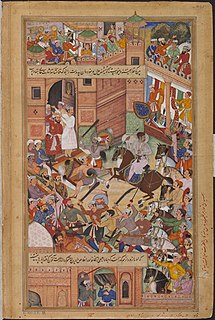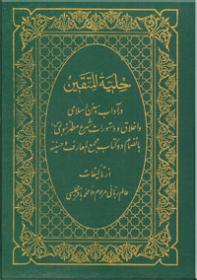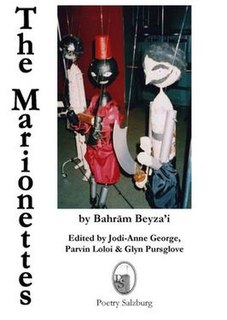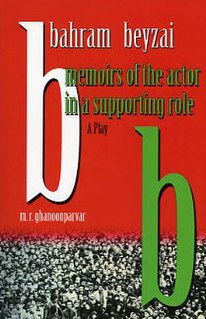 W
WThe Akbarnama, which translates to Book of Akbar, the official chronicle of the reign of Akbar, the third Mughal Emperor, commissioned by Akbar himself and written by his court historian and biographer, Abu'l-Fazl ibn Mubarak. It was written in Persian, which is the literary language of the Mughals, and includes vivid and detailed descriptions of his life and times. It followed the Baburnama, the more personal memoir by his grandfather, Babur, founder of the dynasty. Like that, it was produced in the form of lavishly illustrated manuscripts.
 W
WAlef-Laam Khomeini is a book written by Hedayatollah Behboudi, which is regarding the biography of Iran's 1st/former supreme leader, Seyyed Ruhollah Khomeini. This book was published by the institute of "Motale'at wa Pazhuheshhaye Siasi" in 2018; and has obtained Jalal Al-e Ahmad Literary Award, and also Iran's Book of the Year Awards.
 W
WĀsār-e Ajam is a travelogue and historical book written by Forsat Shirazi between 1881 and 1895 which mostly contains first-hand biographical information about the elite of Fārs, sources on the history of the region as well as its geography. It also involves a collection of more than fifty drawings of various historical sites of Persia, especially Fārs. It is an important book because of accurate renditions with Qajar style—of the reliefs and buildings at Persepolis.
 W
WAzari or the Ancient Language of Azerbaijan is a treatise written by the Iranian scholar Ahmad Kasravi in 1925, about the history of the Azeri language. This book has been approved by orientalists. In this book, Kasravi, using numerous documents and manuscripts, argues that the Old Azeri language should not be categorized as a member of the Turkic languages, but as an Iranian language, a descendant of the Median language.
 W
WBaharestan,, , is a Persian book written by Jami that contains prose. It has stories, tales and moral advice mainly in prose, but also in poetry. Baharestan is divided into eight chapters, an introduction, and a final part. Each of its chapters is called a rowzeh. Jami wrote this book in a year in the 9th century after Muhammad's departure to Medina. In the introduction of Baharestan, Jami stated that he had written this book in the style of Saadi Shirazi's Gulistan for his son who was ten years old at the time and was studying. Baharestan has content about Sufism and mysticism. There are 469 verses of poetry in this book; 16 verses being in Arabic and the rest in Persian. Baharestan has saj' in its texts and the type of its prose is rhymed prose; i.e. it is rhythmic. Each chapter in Baharestan has a specific topic; for example, in the seventh chapter, the topic is the life and the biography of some poets.
 W
WThe Bahr al-Hayāt or Ocean of Life is an illustrated Persian book, published c. 1602 by Muhammad Ghawth, which covers topics including asanas used for meditation. It is probably the first illustrated textbook of yoga.
 W
WDozing-off is a 2012 play by Ali Nassirian which depicts the relationship between an actor and his wife on a journey. Mohsen Moeini worked on the project as a dramaturgist, using "Memories of Destruction", a series of paintings by Aydin Aghdashloo. The play premiered in autumn 2012, and ran for two months in Niavaran Cultural Center. It was directed by Mohsen Moeini, produced by Negin Mirhasani Vahed, and starred Ali Nassirian and Mahboobeh Bayat. The music was composed by Ali Ghamsari.
 W
WGhena (book), also known as "the book of Ghina' and Moosiqi (music)" is a Persian Feqhi book which has been written by Iran's supreme leader, Seyyed Ali Khamenei. This religious book which is also known as "Darsnameh Ghina'-and-Moosiqi", includes the text of 76 sessions from the Fiqh sessions of haram (illegal) gains of Seyyed Ali Khamenei in regards to the subject of Ghina' and music.
 W
WHilyat al-Muttaqin is a Hadith book of Muhammad Baqir al-Majlisi. This work is written in Persian about Islamic morality, instructions and traditions. It was translated into English by Sayyid Athar Husayn S.H. Rizvi and published by Ansariyan Publications in 2013.
 W
WJahangusha-i Naderi, is a book on the reign and wars of Nader Shah, written by Mirza Mehdi Khan Astarabadi, Nader's official historian. Jahangusha-i Naderi is the most important book on the history of Iran during Nader's rule. The author of the book was a companion of Nader and he saw many of the events with his own eyes.
 W
WKalāt Claimed is a play by Bahram Beyzai.
 W
WKelidar is a novel written by Mahmoud Dowlatabadi. The novel consists of ten books in five volumes. The book was written in 15 years, and includes Iranian Folklore themes. Kelidar has been translated into different languages. Kelidar refers to the name of a mountain and a village in Khorasan, where the events of the novel take place.
 W
WThe leopards who have run with me is a Persian language short story collection written by Iranian writer Bijan Najdi. The book was published in Iran in 1997.
 W
WLessons with Kiarostami is a book written by Abbas Kiarostami, edited by Paul Cronin and with a foreword by acclaimed British director Mike Leigh. The book was published, simultaneously in English and Persian, shortly before Kiarostami's death. Drawn from Cronin's notes made at a series of workshops around the world, as led by Kiarostami, the text is written in the first person, from Kiarostami's point of view, and details his working methods and approach to poetic cinema. Lessons with Kiarostami was released alongside various volumes of English translations of Kiarostami's poetry, including In the Shadow of Trees. A Turkish translation and a Simplified Chinese translation of the book were published in 2017, and a Complex Chinese translation in 2018.
 W
WThe Marionettes (1963) is a puppetry play by Bahram Beyzai, and one of the most important plays of the Persian language. It has been staged numerous times in various languages around the world. Together with two subsequent plays, namely Evening in a Strange Land (1963) and The Story of the Hidden Moon (1963), The Marionettes constitutes the playwright's puppet trilogy.
 W
WMemoirs of the Actor in a Supporting Role is a 1982 play by Bahram Beyzai.
 W
WNasirean Ethics or Muhtashami Ethics is a 13th century Persian book in philosophical ethics that is written by Khaje Nasir al-Din al-Tusi. This book is divided to three part: ethics, domestic economy and politics.
 W
WThe Nimatnama-i-Nasiruddin-Shahi is a medieval Indian cookbook, written in Persian language using Naskh script, of delicacies and recipes, and some accompanying paintings illustrating the preparation of the recipes. It was started for Ghiyath Shah, the ruler of the Malwa Sultanate in central India. After he was forced to abdicate, it was completed for his son 'Abd al-Muzaffar Nasir Shah..
 W
WPalestine from the Perspective of Ayatollah Khamenei is a 2011 book excerpting many statements of Iranian Supreme Leader Ayatollah Ali Khamenei about Palestine and Israel. The book and consists of 8 chapters and 416 pages. It is currently available in Iran only, while an Arabic translation is promised.
 W
WThe Persian Bayán is one of the principal scriptural writings of the Báb, the founder of Bábi religion, written in Persian. The Báb also wrote a shorter book in Arabic, known as the Arabic Bayán.
 W
WPersian Inscriptions on Indian Monuments is a book written in Persian by Dr Ali Asghar Hekmat E Shirazi and published in 1956 and 1958 and 2013. New edition contains the Persian texts of more than 200 epigraphical inscriptions found on historical monuments in India, many of which are currently listed as national heritage sites or registered as UNESCO world heritage, published in Persian; an English edition is also being printed.
 W
W"Persian manuscript in Japan" is a Persian inscription from 1217 AD that was written by a Persian in Quanzhou of China for a Japanese monk Keisei, a poem of Shahname Ferdusi. It is designated as a national important cultural property (artwork) in Japan. It is the oldest existing Persian document in Japan. the Persian manuscript in Japan had been wrote in 3 part. they were very famous poem in persian language. the first part is from Vis and Rāmin second part is from Shahnameh and third part mentioned both in Jami' al-tawarikh and also shahnameh and it is sorrow farewell of Iraj from Fereydun.
 W
WThe Sharafnama is the famous book of Sharaf al-Din Bitlisi (1543–1599), which he wrote in 1597, in Persian. Sharafnama is regarded as an important and oldest source on Kurdish history. It deals with the different Kurdish dynasties such as, Saladin the Great and his Ayyubid Dynasty, ancient and Medieval Kurdish principalities in the Middle-East and the Caucasus, as well as some mentioning about the pre-Islamic ancestors of the Kurds.
 W
WSharh-e Esm is the biography of the supreme leader of Iran, Ali Khamenei. The book is written by Hedayatollah Behboudi, and has been translated in some other languages. It was published by the institute of Motaale’at wa Pazjuheshhayeh Siyasi.
 W
WA Study on Iranian Theatre (1965) is Bahram Beyzai's seminal research on theater in the Persian world from the ancient times to the twentieth century. It has been described as "the definitive work on the history of Persian theatre."
 W
WThe Süleymannâme is an illustration of Suleiman the Magnificent's life and achievements. In 65 scenes the miniature paintings are decorated with gold, depicting battles, receptions, hunts and sieges. Written by Fethullah Arifi Çelebi in Persian verse, and illustrated by five unnamed artists, the Süleymannâme was the fifth volume of the first illustrated history of the Ottoman dynasty. It was written in the manner of the Iranian Shahnameh epic. The original version of the Süleymannâme lies in the Topkapi Palace Museum in Istanbul and there is another manuscript in Astan Quds Razavi, the manuscript numbered as manuscript 4249 in Astan Quds Razavi library.
 W
WThe Tārīkh-e ʿĀlam-ārā-ye ʿAbbāsī recorded the history of the Iranian Safavid dynasty, from its founding under Shah Ismail I to the end, under Shah Abbas I, covering the period of 1600-1680. The book was written by the special secretary and counsellor to the Safavid court of Shah Abbas I, Eskandar Beg Munshi who had been an eyewitness to most of the events or consulted other eyewitnesses.
 W
WThe Tarikh-i Qum is a book about the history of the city of Qom, written by Hasan ibn Muhammad Qumi, in Arabic, in 988. The original work is now lost, but a 15th-century Persian translation by Hasan ibn Ali Qumi has been preserved.